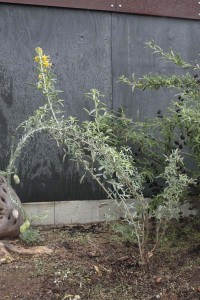Fall: Prime time to sow many seeds in California’s mediterranean climate. Self-sown generations of clarkia, poppies, baby blue eyes, buckwheats and lupines are showing up all around the garden.
But this year has pulled me in lots of directions and I haven’t put a lot of effort into sowing seeds. Also, part of this lack of motivation is an attempt to accept the reality that the garden is pretty full as it stands, and I try resist the delusion that a plant growing from a tiny seed won’t take up as much space as a nearly mature one from the nursery. Consequently the only active seed-sowing I’ve taken part in has been limited to two very different kinds of plants: the California-native bladderpod and some carnivorous plants.
The bladderpod was mainly an experiment. The pods that give Isomeris arborea its common name are full of seeds the size of dried peas. How easy would they be from seed?
Very easy, as it turns out. I opened up a couple pods and buried the seeds about a quarter to half inch in these pots just two weeks ago. Here they are, showing almost 100% germination and phenomenal seedling vigor.

Now that I see they’re really easy from seed I can check out the other thing thing I was curious about. I have two bladderpods in the garden. One is slow-growing but is assuming a nice upright posture. The other is an exuberant floppy mess of green-gray leaves and yellow flowers. Both forms have their use in the garden, but I was really hoping for more upright growth patterns when I put them in the garden.
My seedlings come from the more upright plant, so we’ll see whether they follow mom’s growth habits when placed in various locations around the yard. Is the difference in growth habit nature or nurture? Might I have a consistently strain of upright-growing bladderpods on my hands?
In the native plant community growing specific strains or cultivars is often looked down upon as reducing natural variation and dumbing down the gene pool. But in the garden it’s useful to know what kind of plant you’re getting. A gardener might be disappointed to end up with a low mound instead of an open upright shrub. The customer might never buy another native plant again and instead fill their yard with hydrangeas. They’d spend thousands of gallons watering their hydrangeas, there’d be no more water for people and plants, and civilization as we know it would collapse.
Anyway, so far this has been really easy. Next post I’ll look at my more high energy-input efforts to grow some carnivorous plants from seed.


